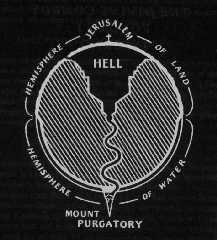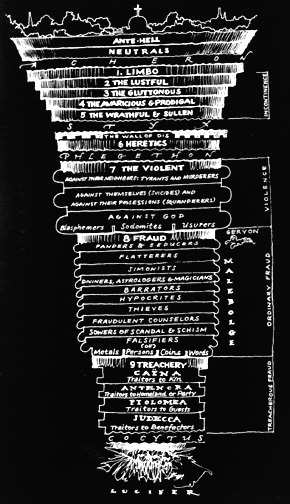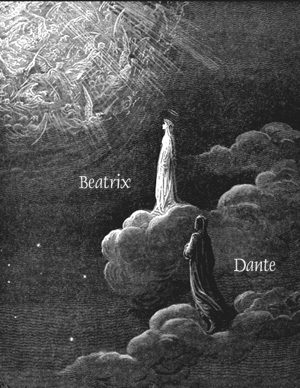|
Dante Alighieri' s masterpiece, the Divine Comedy, and its parallelism with Final Fantasy VII

For those of you who absolutely don' t know a thing about the Divine Comedy ( shame on you!!! ) , it can be perhaps considered the greatest masterpiece of Italian as well as international literature. Dante Alighieri, its well-known author, is also the main character of the Comedy, that is in fact a didactic-allegorical composition in which Dante imagines to engage a journey through the three after-life realms ( according to Christian religion ) , i. e. Inferno ( Hell ) , Purgatory and Paradise. Now I' m sure you could ask: What does that have to do with Final Fantasy VII? All right, I' ll focus to the point: Dante' s representation of Inferno and of Satan has many resemblances with the Shinra Mansion but, best of all, with the Northern Cave and Sephiroth himself. Moreover, the woman figure Dante describes as his only possible guide to the Divine Grace ( that' s to say Beatrix, Beatrice ) is some way similar to Aeris Gainsborough and to the role she plays throughout the adventure. So, let' s start examining a little closer the common elements between the literary ( the Comedy ) and the virtual ( FFVII ) masterpiece.

What you see above is the structure of the first part of Dante' s journey, starting from the sacred city of Jerusalem: from there, he descends into the depths of Hell which, according to his own conception influenced by Christian theology, is an inverted cone expanding beneath the boreal hemisphere of the world and reaching earth' s center. So, the poet crosses the first after-life realm by going through the nine " Cerchi " ( Circles - see the picture below ) which it is composed with, where the damned souls are punished for their sins. The deeper they are located, the worse is their blame and sin: every Circle corresponds to a particular one, from Luxury, Gluttony etc. to Fraud and Trecherous Fraud, this way 'till the center of the earth, where Lucifer lies chained to the eternal glaciers. In fact, the Hell itself was originated by the infamous fall of the angel ( Lucifer ) who had dared to stand against God, and because of that was banished from Paradise and fell down into the earth.

Parallelism N° 1: If you consider the Shinra Mansion along with the Northern Cave, you will surely notice that are very similar to Dante' s Inferno. Inside the Mansion, Cloud had to descend through a sort of a well ( an INVERTED CONE ) using some spiral stairs in order to reach the basement, where Satan ( Sephiroth ) was waiting for him. Same thing in the Northern Cave, another INVERTED CONE that you can access from a sacred place ( The Promised Land ) : and, just at the CENTER of the Planet, there is Sephiroth that, like Lucifer the fallen angel, is trapped in a Mako womb ( it could remind a glacier... ) and is, in the end, another evil angel, but with only a single wing. Another important characteristic, appearing in the Comedy and in the two place mentioned above, is the fact that both Dante and Cloud descend ANTICLOCKWISE: if you can call it a coincidence...
But, as I' ve early said, there is another interrelationship between the Divine Comedy and Final Fantasy VII, as we can see expressed by the figures of Beatrice and Aeris. When Dante reaches the Earthly Paradise, at the top of the Mount Purgatory, his guide that led him so far ( i. e. Vergilius - Virgil ) leaves him for he cannot go any further: the sublime guide destined to open towards Dante the gates of Paradise is Beatrice ( Dante' s angelic woman of Stil Novo ) . She summarizes the highest female and Christian virtues, and she represents the necessary " illumination " that man needs to be shown God and His Divine Grace. Her name itself has an important meaning in this optic: Beatrice means " The woman who confers beatitude " , and we know that the beatitude Dante is searching for is nothing but the Supreme Bliss to be purified and to be able to be with God, to be in His Grace. Therefore, Beatrice will be by Dante' s side during his last journey, that is obviously through Paradise.

Parallelism N° 2: Aeris Gainsborough, together with Beatrice, died ante diem ( i. e. too early ) : as Dante cried for the loss of the woman he adored most, so Cloud resented Sephiroth for having killed his loved one. And, after Beatrice' s death, the poet idealized her and made her one of the landmarks in his Comedy, the spirit who can save every man from soul' s death, the spirit who can grant him salvation. From this point of view, Aeris is no different from Dante' s angelic woman: Aeris is the one that, by sacrificing herself for the sake of the Planet, can spare every lifeform from the disaster ( Meteor, corresponding to damnation, is defeated by Holy, corresponding to salvation ) and guide Cloud and the others to the final showdown against Sephiroth, lighting their paths and resolutions.
So, the parallelisms I just spoke about can be summarized in the following table:
|
Divine Comedy
Dante
Beatrice
Lucifer
Hell
Jerusalem
Salvation
Damnation |
<--->
<--->
<--->
<--->
<--->
<--->
<---> |
Final Fantasy VII
Cloud
Aeris
Sephiroth
Northern Cave, Shinra Mansion
The Promised Land
Holy
Meteor |
|